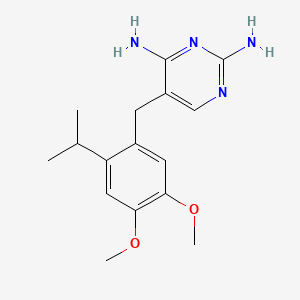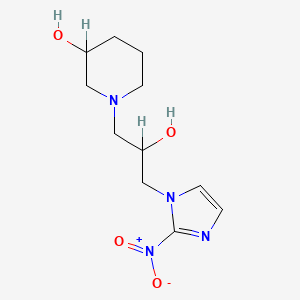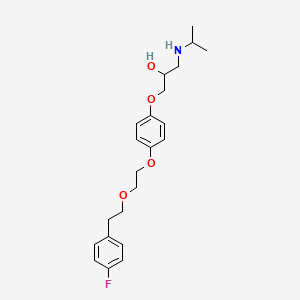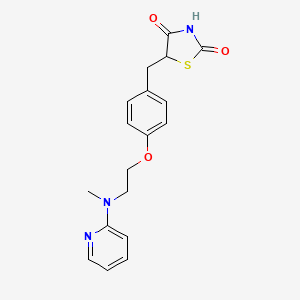
Rosiglitazone
Overview
Description
Rosiglitazone is a synthetic compound belonging to the thiazolidinedione class of drugs. It is primarily used as an antidiabetic agent to improve glycemic control in patients with type 2 diabetes mellitus. This compound functions as an insulin sensitizer by binding to peroxisome proliferator-activated receptors in fat cells, enhancing the cells’ responsiveness to insulin .
Mechanism of Action
Target of Action
Rosiglitazone primarily targets the Peroxisome Proliferator-Activated Receptors (PPARs) , specifically PPARγ . PPARs are a group of nuclear receptor proteins that function as transcription factors regulating the expression of genes. PPARγ is involved in the regulation of fatty acid storage and glucose metabolism .
Mode of Action
This compound acts as a selective ligand of PPARγ, meaning it binds to this receptor and activates it . This activation regulates the transcription of certain genes involved in glucose and lipid metabolism, insulin sensitivity, and anti-inflammatory response .
Biochemical Pathways
This compound’s activation of PPARγ impacts several biochemical pathways. It’s involved in metabolic pathways, carbon metabolism, and the citrate cycle . By influencing these pathways, this compound can help regulate glucose levels and lipid metabolism, which are crucial for managing conditions like type 2 diabetes .
Result of Action
This compound’s action leads to several molecular and cellular effects. It improves insulin sensitivity, which helps lower blood glucose levels . It also appears to have an anti-inflammatory effect, as evidenced by the decrease in nuclear factor kappa-B (NFκB) levels and increase in inhibitor (IκB) levels in patients on this compound . Furthermore, it has been found to promote adipocyte browning, which could have implications for obesity treatment .
Action Environment
The efficacy and stability of this compound can be influenced by various environmental factors. For instance, the drug is indicated as an adjunct to diet and exercise to maintain glycemic control in type 2 diabetes, suggesting that lifestyle factors can impact its effectiveness . .
Biochemical Analysis
Biochemical Properties
Rosiglitazone works by activating the intracellular receptor class of the peroxisome proliferator-activated receptors (PPARs), specifically PPARγ . It is a selective ligand of PPARγ, and has no PPARα-binding action . Apart from its effect on insulin resistance, it appears to have an anti-inflammatory effect .
Cellular Effects
This compound has been shown to suppress the growth of human glioma cell lines U87 and U251 . It also induces cell cycle arrest and apoptosis . In addition, this compound has been found to exhibit anti-inflammatory properties and can target cardiomyocytes secreting CXCL10, under interferon (IFN)γ and tumor necrosis factor (TNF)α challenge .
Molecular Mechanism
The mechanism of action of this compound is by activation of the intracellular receptor class of the peroxisome proliferator-activated receptors (PPARs), specifically PPARγ . This compound is a selective ligand of PPARγ, and has no PPARα-binding action . Apart from its effect on insulin resistance, it appears to have an anti-inflammatory effect: nuclear factor kappa-B (NFκB) levels fall and inhibitor (IκB) levels increase in patients on this compound .
Temporal Effects in Laboratory Settings
This compound has been shown to have a significant effect on the reduction of glucose and HbA1c treatment effects in rats . This effect was observed over a period of 6 weeks of treatment with this compound .
Dosage Effects in Animal Models
In animal models, this compound has been shown to be the most effective treatment in thiazolidinediones (TZDs) not only for its hypoglycemic effect but also for its additional effects such as anti-inflammatory and anti-cancer capabilities, retinopathy, and ischemia–reperfusion injury protection effects .
Metabolic Pathways
This compound is extensively metabolized in the liver to inactive metabolites via N-demethylation, hydroxylation, and conjugation with sulfate and glucuronic acid . In vitro data have shown that Cytochrome (CYP) P450 isoenzyme 2C8 (CYP2C8) and to a minor extent CYP2C9 are involved in the hepatic metabolism of this compound .
Transport and Distribution
This compound is primarily distributed in the liver, where it is extensively metabolized . It is also distributed in fat cells, where it works as an insulin sensitizer, by binding to the PPAR in fat cells and making the cells more responsive to insulin .
Subcellular Localization
This compound acts at the level of the nucleus, where it binds to the peroxisome proliferator-activated receptors (PPARs), specifically PPARγ . This binding activates the PPARγ, leading to the transcription of insulin-responsive genes involved in the control of glucose production, transport, and utilization .
Preparation Methods
Synthetic Routes and Reaction Conditions
The synthesis of rosiglitazone involves several key steps:
Reaction of 2-chloropyridine with 2-methylaminoethanol: This reaction is catalyzed by trityl sodium to produce 2-[N-methyl-N-(2-pyridine)amino]ethanol.
Williamson Synthesis Reaction: The N-substituted benzaldehyde and 4-fluorobenzaldehyde undergo a Williamson synthesis reaction catalyzed by bis(trimethylsilyl)amino potassium to form 4-[2-[N-methyl-N-(2-pyridine)amino]ethoxy]benzaldehyde.
Condensation Reaction: The resulting compound is then condensed with thiazoline-2,4-diketone to yield 5-{4-[2-[N-methyl-N-(2-pyridine)amino]ethoxy]benzylidene}thiazoline-2,4-diketone.
Reduction Reaction: Finally, the compound undergoes a reduction reaction catalyzed by an organic manganese reagent to produce this compound.
Industrial Production Methods
For industrial production, the synthesis of this compound is optimized for scalability and efficiency. The process involves a five-step synthetic route with commercially available starting materials, including 2-chloropyridine, N-methylethanolamine, 4-fluorobenzaldehyde, and 1,3-thiazolidine-2,4-dione. The steps include cyclization, alkylation, etherification, condensation, and reduction, with an overall yield of approximately 40% .
Chemical Reactions Analysis
Types of Reactions
Rosiglitazone undergoes various chemical reactions, including:
Condensation: The condensation reaction with thiazoline-2,4-diketone is a crucial step in its synthesis.
Common Reagents and Conditions
Sodium Borohydride: Used in the reduction step.
Cobalt Chloride Hexahydrate and Dimethylglyoxime: Catalysts for the reduction reaction.
Trityl Sodium: Catalyst for the reaction of 2-chloropyridine with 2-methylaminoethanol.
Bis(trimethylsilyl)amino Potassium: Catalyst for the Williamson synthesis reaction.
Major Products Formed
The major product formed from these reactions is this compound itself, with intermediate compounds such as 2-[N-methyl-N-(2-pyridine)amino]ethanol and 4-[2-[N-methyl-N-(2-pyridine)amino]ethoxy]benzaldehyde .
Scientific Research Applications
Rosiglitazone has a wide range of scientific research applications:
Chemistry: Used as a model compound in studies of thiazolidinedione synthesis and reaction mechanisms.
Biology: Investigated for its effects on insulin sensitivity and glucose metabolism.
Medicine: Primarily used to treat type 2 diabetes mellitus by improving insulin sensitivity.
Industry: Utilized in the pharmaceutical industry for the production of antidiabetic medications.
Comparison with Similar Compounds
Similar Compounds
Pioglitazone: Another thiazolidinedione used to treat type 2 diabetes mellitus.
Troglitazone: A thiazolidinedione that was withdrawn from the market due to hepatotoxicity concerns.
Uniqueness of Rosiglitazone
This compound is unique in its specific binding to PPAR-gamma without affecting PPAR-alpha. Compared to pioglitazone, this compound has been associated with a higher risk of myocardial infarction and congestive heart failure, leading to safety concerns . it remains an effective insulin sensitizer and has been explored for additional therapeutic applications beyond diabetes treatment .
Properties
IUPAC Name |
5-[[4-[2-[methyl(pyridin-2-yl)amino]ethoxy]phenyl]methyl]-1,3-thiazolidine-2,4-dione | |
|---|---|---|
| Source | PubChem | |
| URL | https://pubchem.ncbi.nlm.nih.gov | |
| Description | Data deposited in or computed by PubChem | |
InChI |
InChI=1S/C18H19N3O3S/c1-21(16-4-2-3-9-19-16)10-11-24-14-7-5-13(6-8-14)12-15-17(22)20-18(23)25-15/h2-9,15H,10-12H2,1H3,(H,20,22,23) | |
| Source | PubChem | |
| URL | https://pubchem.ncbi.nlm.nih.gov | |
| Description | Data deposited in or computed by PubChem | |
InChI Key |
YASAKCUCGLMORW-UHFFFAOYSA-N | |
| Source | PubChem | |
| URL | https://pubchem.ncbi.nlm.nih.gov | |
| Description | Data deposited in or computed by PubChem | |
Canonical SMILES |
CN(CCOC1=CC=C(C=C1)CC2C(=O)NC(=O)S2)C3=CC=CC=N3 | |
| Source | PubChem | |
| URL | https://pubchem.ncbi.nlm.nih.gov | |
| Description | Data deposited in or computed by PubChem | |
Molecular Formula |
C18H19N3O3S | |
| Source | PubChem | |
| URL | https://pubchem.ncbi.nlm.nih.gov | |
| Description | Data deposited in or computed by PubChem | |
DSSTOX Substance ID |
DTXSID7037131 | |
| Record name | Rosiglitazone | |
| Source | EPA DSSTox | |
| URL | https://comptox.epa.gov/dashboard/DTXSID7037131 | |
| Description | DSSTox provides a high quality public chemistry resource for supporting improved predictive toxicology. | |
Molecular Weight |
357.4 g/mol | |
| Source | PubChem | |
| URL | https://pubchem.ncbi.nlm.nih.gov | |
| Description | Data deposited in or computed by PubChem | |
Physical Description |
Solid | |
| Record name | Rosiglitazone | |
| Source | Human Metabolome Database (HMDB) | |
| URL | http://www.hmdb.ca/metabolites/HMDB0005031 | |
| Description | The Human Metabolome Database (HMDB) is a freely available electronic database containing detailed information about small molecule metabolites found in the human body. | |
| Explanation | HMDB is offered to the public as a freely available resource. Use and re-distribution of the data, in whole or in part, for commercial purposes requires explicit permission of the authors and explicit acknowledgment of the source material (HMDB) and the original publication (see the HMDB citing page). We ask that users who download significant portions of the database cite the HMDB paper in any resulting publications. | |
Mechanism of Action |
Rosiglitazone acts as a highly selective and potent agonist at peroxisome proliferator activated receptors (PPAR) in target tissues for insulin action such as adipose tissue, skeletal muscle, and liver. Activation of PPAR-gamma receptors regulates the transcription of insulin-responsive genes involved in the control of glucose production, transport, and utilization. In this way, rosiglitazone enhances tissue sensitivity to insulin., Because osteoblasts and marrow adipocytes are derived from a common mesenchymal progenitor, increased adipogenesis may occur at the expense of osteoblasts, leading to bone loss. Our previous in vitro studies indicated that activation of the proadipogenic transcription factor peroxisome proliferator-activated receptor isoform gamma 2 with rosiglitazone suppressed osteoblast differentiation. Here, we show that 5-month-old Swiss-Webster mice receiving rosiglitazone for 28 day exhibited bone loss associated with an increase in marrow adipocytes, a decrease in the ratio of osteoblasts to osteoclasts, a reduction in bone formation rate, and a reduction in wall width--an index of the amount of bone formed by each team of osteoblasts. Rosiglitazone had no effect on the number of early osteoblast or osteoclast progenitors, or on osteoblast life span, but decreased the expression of the key osteoblastogenic transcription factors Runx2 and Osterix in cultures of marrow-derived mesenchymal progenitors. These effects were associated with diversion of bipotential progenitors from the osteoblast to the adipocyte lineage, and suppression of the differentiation of monopotential osteoblast progenitors. However, rosiglitazone had no effect on osteoblastic cells at later stages of differentiation. Hence, rosiglitazone attenuates osteoblast differentiation and thereby reduces bone formation rate in vivo, leading to bone loss. These findings provide a mechanistic explanation for the recent evidence that peroxisome proliferator-activated receptor isoform gamma activation is a negative regulator of bone mass and suggest that the increased production of oxidized fatty acids with age may indeed be an important mechanism for age-related osteoporosis in humans., Brain peroxisome proliferator-activated receptor gamma (PPARgamma), a member of the nuclear receptor superfamily of ligand-dependent transcription factors, is involved in neuroprotection. It is activated by the drug rosiglitazone, which then can increase the pro-survival protein B-cell lymphoma 2 (BCL-2), to mediate neuroprotection. However, the mechanism underlying this molecular cascade remains unknown. Here, we show that the neuroprotective protein neurotrophic factor-a1 (NF-a1), which also induces the expression of BCL-2, has a promoter that contains PPARgamma-binding sites that are activated by rosiglitazone. Treatment of Neuro2a cells and primary hippocampal neurons with rosiglitazone increased endogenous NF-a1 expression and prevented H2 O2 -induced cytotoxicity. Concomitant with the increase in NF-a1, BCL-2 was also increased in these cells. When siRNA against NF-a1 was used, the induction of BCL-2 by rosiglitazone was prevented, and the neuroprotective effect of rosiglitazone was reduced. These results demonstrate that rosiglitazone-activated PPARgamma directly induces the transcription of NF-a1, contributing to neuroprotection in neurons. We proposed the following cascade for neuroprotection against oxidative stress by rosiglitazone: Rosiglitazone enters the neuron and binds to peroxisome proliferator-activated receptor gamma (PPARgamma) in the nucleus. The PPARgamma-rosiglitazone complex binds to the neurotrophic factor-a1 (NF-a1) promoter and activates the transcription of NF-a1 mRNA which is then translated to the protein. NF-a1 is the secreted, binds to a cognate receptor and activates the extracellular signal-regulated kinases (ERK) pathway. This in turn enhances the expression of the pro-survival protein, B-cell lymphoma 2 (BCL-2) and inhibition of caspase 3 (Csp-3) to mediate neuroprotection under oxidative stress. Akt, protein kinase B (PKB)., Rosiglitazone, a member of the thiazolidinedione class of antidiabetic agents, improves glycemic control by improving insulin sensitivity. Rosiglitazone is a highly selective and potent agonist for the peroxisome proliferator-activated receptor-gamma (PPARgamma). In humans, PPAR receptors are found in key target tissues for insulin action such as adipose tissue, skeletal muscle, and liver. Activation of PPARgamma nuclear receptors regulates the transcription of insulin-responsive genes involved in the control of glucose production, transport, and utilization. In addition, PPARgamma- responsive genes also participate in the regulation of fatty acid metabolism, Rosiglitazone acts principally by increasing insulin sensitivity in target tissues, as well as decreasing hepatic gluconeogenesis. Rosiglitazone is a peroxisome proliferator-activated receptorgamma (PPARgamma) agonist that increases transcription of insulin-responsive genes and increases insulin sensitivity. Rosiglitazone, like other thiazolidinediones, ameliorates insulin resistance associated with type diabetes mellitus without stimulating insulin release from pancreatic beta cells, thus avoiding the risk of hypoglycemia. Because rosiglitazone does not lower glucose concentrations below euglycemia, the drug is appropriately referred to as an antidiabetic agent rather than a hypoglycemic agent. Some evidence suggests that the glucoregulatory effects of thiazolidinediones are mediated in part via reduced systemic and tissue lipid availability. Circulating concentrations of insulin and C-peptide are reduced during rosiglitazone therapy. | |
| Record name | Rosiglitazone | |
| Source | DrugBank | |
| URL | https://www.drugbank.ca/drugs/DB00412 | |
| Description | The DrugBank database is a unique bioinformatics and cheminformatics resource that combines detailed drug (i.e. chemical, pharmacological and pharmaceutical) data with comprehensive drug target (i.e. sequence, structure, and pathway) information. | |
| Explanation | Creative Common's Attribution-NonCommercial 4.0 International License (http://creativecommons.org/licenses/by-nc/4.0/legalcode) | |
| Record name | Rosiglitazone | |
| Source | Hazardous Substances Data Bank (HSDB) | |
| URL | https://pubchem.ncbi.nlm.nih.gov/source/hsdb/7555 | |
| Description | The Hazardous Substances Data Bank (HSDB) is a toxicology database that focuses on the toxicology of potentially hazardous chemicals. It provides information on human exposure, industrial hygiene, emergency handling procedures, environmental fate, regulatory requirements, nanomaterials, and related areas. The information in HSDB has been assessed by a Scientific Review Panel. | |
Color/Form |
Colorless crystals from methanol | |
CAS No. |
122320-73-4 | |
| Record name | Rosiglitazone | |
| Source | CAS Common Chemistry | |
| URL | https://commonchemistry.cas.org/detail?cas_rn=122320-73-4 | |
| Description | CAS Common Chemistry is an open community resource for accessing chemical information. Nearly 500,000 chemical substances from CAS REGISTRY cover areas of community interest, including common and frequently regulated chemicals, and those relevant to high school and undergraduate chemistry classes. This chemical information, curated by our expert scientists, is provided in alignment with our mission as a division of the American Chemical Society. | |
| Explanation | The data from CAS Common Chemistry is provided under a CC-BY-NC 4.0 license, unless otherwise stated. | |
| Record name | Rosiglitazone [INN:BAN] | |
| Source | ChemIDplus | |
| URL | https://pubchem.ncbi.nlm.nih.gov/substance/?source=chemidplus&sourceid=0122320734 | |
| Description | ChemIDplus is a free, web search system that provides access to the structure and nomenclature authority files used for the identification of chemical substances cited in National Library of Medicine (NLM) databases, including the TOXNET system. | |
| Record name | Rosiglitazone | |
| Source | DrugBank | |
| URL | https://www.drugbank.ca/drugs/DB00412 | |
| Description | The DrugBank database is a unique bioinformatics and cheminformatics resource that combines detailed drug (i.e. chemical, pharmacological and pharmaceutical) data with comprehensive drug target (i.e. sequence, structure, and pathway) information. | |
| Explanation | Creative Common's Attribution-NonCommercial 4.0 International License (http://creativecommons.org/licenses/by-nc/4.0/legalcode) | |
| Record name | rosiglitazone | |
| Source | DTP/NCI | |
| URL | https://dtp.cancer.gov/dtpstandard/servlet/dwindex?searchtype=NSC&outputformat=html&searchlist=758698 | |
| Description | The NCI Development Therapeutics Program (DTP) provides services and resources to the academic and private-sector research communities worldwide to facilitate the discovery and development of new cancer therapeutic agents. | |
| Explanation | Unless otherwise indicated, all text within NCI products is free of copyright and may be reused without our permission. Credit the National Cancer Institute as the source. | |
| Record name | Rosiglitazone | |
| Source | EPA DSSTox | |
| URL | https://comptox.epa.gov/dashboard/DTXSID7037131 | |
| Description | DSSTox provides a high quality public chemistry resource for supporting improved predictive toxicology. | |
| Record name | 5-(4-(2-(N-METHYL-N-(2-PYRIDYL)AMINO)ETHOXY)BENZYL)THIAZOLIDINE-2,4 -DIONE | |
| Source | European Chemicals Agency (ECHA) | |
| URL | https://echa.europa.eu/information-on-chemicals | |
| Description | The European Chemicals Agency (ECHA) is an agency of the European Union which is the driving force among regulatory authorities in implementing the EU's groundbreaking chemicals legislation for the benefit of human health and the environment as well as for innovation and competitiveness. | |
| Explanation | Use of the information, documents and data from the ECHA website is subject to the terms and conditions of this Legal Notice, and subject to other binding limitations provided for under applicable law, the information, documents and data made available on the ECHA website may be reproduced, distributed and/or used, totally or in part, for non-commercial purposes provided that ECHA is acknowledged as the source: "Source: European Chemicals Agency, http://echa.europa.eu/". Such acknowledgement must be included in each copy of the material. ECHA permits and encourages organisations and individuals to create links to the ECHA website under the following cumulative conditions: Links can only be made to webpages that provide a link to the Legal Notice page. | |
| Record name | ROSIGLITAZONE | |
| Source | FDA Global Substance Registration System (GSRS) | |
| URL | https://gsrs.ncats.nih.gov/ginas/app/beta/substances/05V02F2KDG | |
| Description | The FDA Global Substance Registration System (GSRS) enables the efficient and accurate exchange of information on what substances are in regulated products. Instead of relying on names, which vary across regulatory domains, countries, and regions, the GSRS knowledge base makes it possible for substances to be defined by standardized, scientific descriptions. | |
| Explanation | Unless otherwise noted, the contents of the FDA website (www.fda.gov), both text and graphics, are not copyrighted. They are in the public domain and may be republished, reprinted and otherwise used freely by anyone without the need to obtain permission from FDA. Credit to the U.S. Food and Drug Administration as the source is appreciated but not required. | |
| Record name | Rosiglitazone | |
| Source | Hazardous Substances Data Bank (HSDB) | |
| URL | https://pubchem.ncbi.nlm.nih.gov/source/hsdb/7555 | |
| Description | The Hazardous Substances Data Bank (HSDB) is a toxicology database that focuses on the toxicology of potentially hazardous chemicals. It provides information on human exposure, industrial hygiene, emergency handling procedures, environmental fate, regulatory requirements, nanomaterials, and related areas. The information in HSDB has been assessed by a Scientific Review Panel. | |
| Record name | Rosiglitazone | |
| Source | Human Metabolome Database (HMDB) | |
| URL | http://www.hmdb.ca/metabolites/HMDB0005031 | |
| Description | The Human Metabolome Database (HMDB) is a freely available electronic database containing detailed information about small molecule metabolites found in the human body. | |
| Explanation | HMDB is offered to the public as a freely available resource. Use and re-distribution of the data, in whole or in part, for commercial purposes requires explicit permission of the authors and explicit acknowledgment of the source material (HMDB) and the original publication (see the HMDB citing page). We ask that users who download significant portions of the database cite the HMDB paper in any resulting publications. | |
Melting Point |
122-123 °C, 153-155 °C | |
| Record name | Rosiglitazone | |
| Source | DrugBank | |
| URL | https://www.drugbank.ca/drugs/DB00412 | |
| Description | The DrugBank database is a unique bioinformatics and cheminformatics resource that combines detailed drug (i.e. chemical, pharmacological and pharmaceutical) data with comprehensive drug target (i.e. sequence, structure, and pathway) information. | |
| Explanation | Creative Common's Attribution-NonCommercial 4.0 International License (http://creativecommons.org/licenses/by-nc/4.0/legalcode) | |
| Record name | Rosiglitazone | |
| Source | Hazardous Substances Data Bank (HSDB) | |
| URL | https://pubchem.ncbi.nlm.nih.gov/source/hsdb/7555 | |
| Description | The Hazardous Substances Data Bank (HSDB) is a toxicology database that focuses on the toxicology of potentially hazardous chemicals. It provides information on human exposure, industrial hygiene, emergency handling procedures, environmental fate, regulatory requirements, nanomaterials, and related areas. The information in HSDB has been assessed by a Scientific Review Panel. | |
Synthesis routes and methods I
Procedure details





Synthesis routes and methods II
Procedure details





Retrosynthesis Analysis
AI-Powered Synthesis Planning: Our tool employs the Template_relevance Pistachio, Template_relevance Bkms_metabolic, Template_relevance Pistachio_ringbreaker, Template_relevance Reaxys, Template_relevance Reaxys_biocatalysis model, leveraging a vast database of chemical reactions to predict feasible synthetic routes.
One-Step Synthesis Focus: Specifically designed for one-step synthesis, it provides concise and direct routes for your target compounds, streamlining the synthesis process.
Accurate Predictions: Utilizing the extensive PISTACHIO, BKMS_METABOLIC, PISTACHIO_RINGBREAKER, REAXYS, REAXYS_BIOCATALYSIS database, our tool offers high-accuracy predictions, reflecting the latest in chemical research and data.
Strategy Settings
| Precursor scoring | Relevance Heuristic |
|---|---|
| Min. plausibility | 0.01 |
| Model | Template_relevance |
| Template Set | Pistachio/Bkms_metabolic/Pistachio_ringbreaker/Reaxys/Reaxys_biocatalysis |
| Top-N result to add to graph | 6 |
Feasible Synthetic Routes
Disclaimer and Information on In-Vitro Research Products
Please be aware that all articles and product information presented on BenchChem are intended solely for informational purposes. The products available for purchase on BenchChem are specifically designed for in-vitro studies, which are conducted outside of living organisms. In-vitro studies, derived from the Latin term "in glass," involve experiments performed in controlled laboratory settings using cells or tissues. It is important to note that these products are not categorized as medicines or drugs, and they have not received approval from the FDA for the prevention, treatment, or cure of any medical condition, ailment, or disease. We must emphasize that any form of bodily introduction of these products into humans or animals is strictly prohibited by law. It is essential to adhere to these guidelines to ensure compliance with legal and ethical standards in research and experimentation.
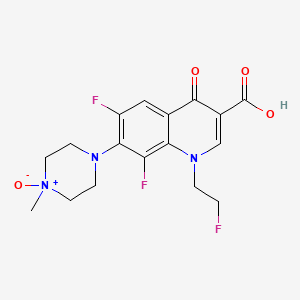
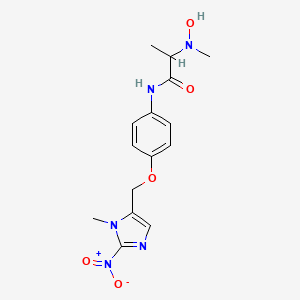
![Sodium;3-[(3R,4S,5S,7R)-7-[(3S,5S)-5-ethyl-5-[(5R,6S)-5-ethyl-5-hydroxy-6-methyloxan-2-yl]-3-methyloxolan-2-yl]-4-hydroxy-3,5-dimethyl-6-oxononyl]-6-methyl-2,4-dinitrophenolate](/img/structure/B1679461.png)

![6-(2-Chlorophenyl)-4h-imidazo[1,5-a][1,4]benzodiazepine-3-carboxamide](/img/structure/B1679466.png)
![(2E,4E)-5-(3-methoxyphenyl)-N-[(2R)-5-pyridin-3-ylpentan-2-yl]nona-2,4-dienamide](/img/structure/B1679469.png)
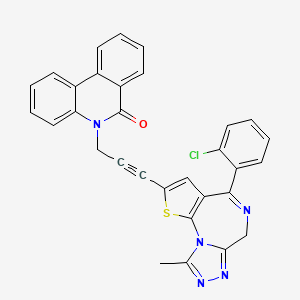

![5-[4-(4-Nitrophenyl)piperazin-1-yl]-5-(4-phenylphenyl)-1,3-diazinane-2,4,6-trione](/img/structure/B1679473.png)
